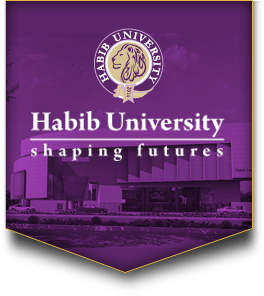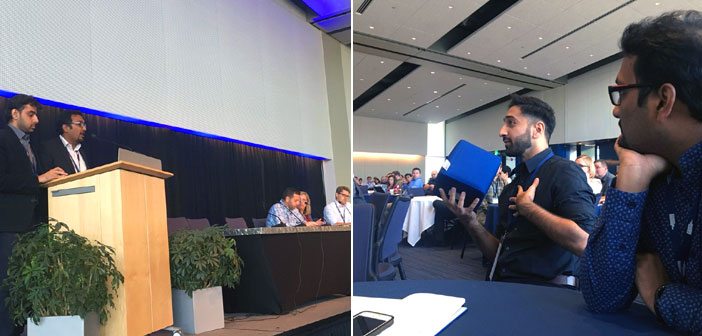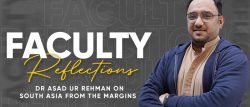Every day, new ideas are coming to fruition in these community workshops, where thinkers and tinkerers can go to create things that might otherwise never see the light of day, thanks to the shared resources offered there.
Makerspaces give individuals access to technologies needed to bring their ideas to life. It connects creators with collaborators, organisations, and fundraising opportunities. Habib University created its own such space, the Playground – Centre for Transdisciplinarity, Design and Innovation, which was launched in August 2017.
Dr. Anzar Khaliq, Dr. Basit Memon, and Gulraiz Khan, three of Habib University’s faculty members, attended the International Symposium on Academic Makerspaces (ISAM) from the 24th to 28th of September. Hosted by Case Western Reserve University, the symposium is a project of HEMI (Higher Education Maker Initiative). Started by MIT, it is a collaboration by eight higher education institutions: CWRU, University California- Berkeley, Carnegie Mellon University Georgia institute of Technology, MIT, Olin College, Stanford University, and Yale University. About 350 people were present at the conference from all around the world.
”
@HabibUniversity faculty members @anzarkhaliq & @gulraizkhan at the Makerspace mission, vision and goals panel at #ISAMCWRU pic.twitter.com/OKfkVQFbuv
— Gulraiz Khan (@gulraizkhan) September 26, 2017
Having attended the conference for the second time, the HU faculty presented two papers on design and innovation learning spaces. As one of the newer institutions at the symposium, they got acquainted with safety practices, equipment purchases, and emerging technologies and efforts made by other institutions. Dr. Memon explained how “education, especially when having an engineering background, is moving expeditiously towards learned experiences and further from textbook learning.” Makerspaces, in this case, become an important part of a student’s learning process, creating a space that is “co-owned by the students, in contrast to typical lab spaces that are owned by the institutions”. The developing makerspace culture is one that actively involves students and gives them unlimited access to creating, innovating and prototyping at any time.
”
Puppy pits!? @HabibUniversity is doing some remarkable work infusing making throughout their institution. #ISAMCWRU pic.twitter.com/hVN8Xwx6Db
— Zack Dowell (@noiseprofessor) September 26, 2017
Habib University’s Playground, according to the faculty members, is a makerspace ecosystem: a community space where members can engage with the campus community and beyond at any given time. The Playground helps in reducing barriers of interaction and learning between disciplines and schools. As a learning and teaching space, “by its very nature, the Playground makes it easier to interact and collaborate across schools.” Dr. Memon, reflecting on other institutions at the symposium, stated that “due to a close proximity of spaces, from the get-go, you [HU students and faculty] get open access to other spaces around the university,” thereby allowing students to learn from each other before proceeding to use lab spaces they may be unfamiliar with.
“We see the Playground also as a place to promote transdisciplinarity and a place to bring in innovation. In the future, we are also looking to extend this to entrepreneurship. When held to international comparison, HU’s setting plays a vital role in the way the makerspace works. Because we are a close knit group, we have a lot of possibilities for interaction,” said Dr. Memon. Ideation and experimentation, as well as asking questions and various kinds of research, lead to finding a problem. All this is the necessary baseline of finding good solutions which can develop into viable entrepreneurial projects.
”
Colleagues in Crime I, from #Karachi to #NewYork https://t.co/7qoUFHRbiy pic.twitter.com/cQPyplnuNc
— Gulraiz Khan (@gulraizkhan) October 1, 2017
Dr. Khaliq too, brought up the limitations other universities face internationally due to their size: “it is difficult for them to build a culture where they are able to come together. HU by design is blessed with such a structure that by virtue of being small and not having physical boundaries, we are able to naturally explore connections across disciplines.”
From their observations of the previous conference, the faculty went to the symposium to challenge the idea of a makerspace being open only to engineers or one particular school. Dr. Khaliq explained in their presentation, “if making is about designing interesting solutions to problems, then it has both hardware and software manifestations in the modern world”, stating that people with different areas of expertise should be brought together. He went on to explain that the process of making comes from empathy, “if you are very well aware of the problems surrounding you and you are interested in solving them, then the work you produce is very well thought out”. The emphasis placed by the HU faculty was on “making not just for the sake of making, but making with a mission.”
”
Really, really impressed with the work getting done at @HabibUniversity. #isamcwru https://t.co/6ze3YwwYs5
— Eric D. M. Johnson (@ericdmj) September 26, 2017
International audiences saw the Playground at Habib University as a “daring and innovative” project, as HU uniquely combines students of a strong liberal arts background with those of an engineering background, in one space to work on issues together. Other attendees of the symposium were also in awe of the picture of Pakistan presented to them. Many of them were appreciative of the faculty for helping them develop a better understanding of engineering in the Global South, especially due to the fact that many of them who want to work with a third world country assumed “the solutions developed in the West are best for everyone”.
”
#ISAMCWRU yohsin = striving 4 Excellence; appreciating Aesthetics; nrtring Passion; Rspctng othrs; Srvng the communities in which we reside.
— Georgetown Maker Hub (@gumakerhub) September 25, 2017
Further discussions enabled a better understanding of Pakistani cities and their uniqueness. The overall feedback the faculty received was highly positive. Members of the symposium were curious to see the future of such a “creative initiative and how far the impact in the region would reach”. Many also approached the faculty to find out about whether students or faculty of other institutes could attend HU for study. The academic model of HU was seen as extremely smart for combining liberal arts and engineering, even for those from countries like the USA. For Dr. Anzar the feedback on the university structure was an achievement: “our uniqueness is not a feature we want to keep. If we truly believe this is a good education model, then it needs to be replicated.”




